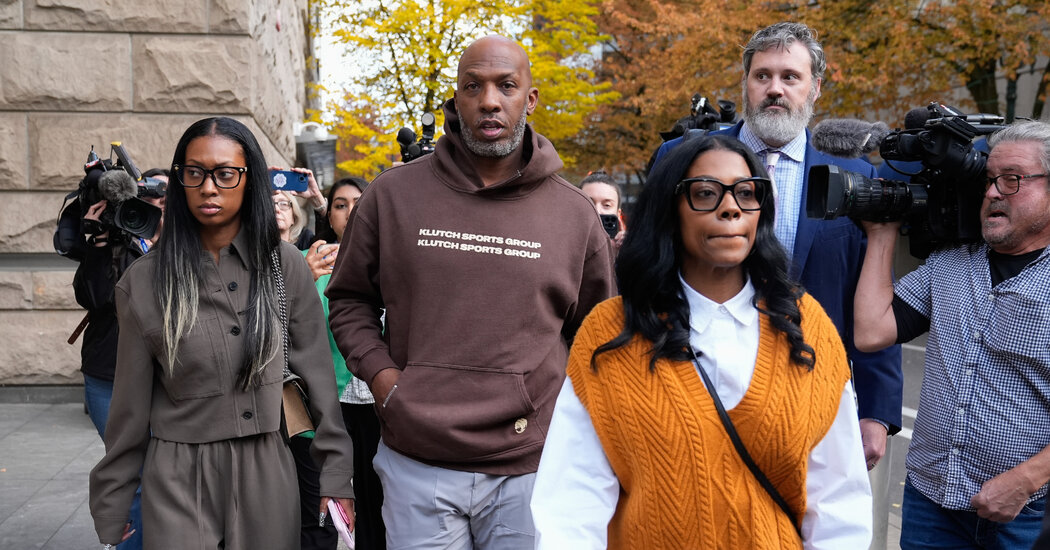The squat, brick building on Lexington Avenue in Manhattan looked like any other on the block, with no hint of the elaborate trap within.
In the summer of 2023, a man — we’ll call him, as prosecutors do, John Doe #1 — walked into the building and sat down at an invitation-only, backroom poker table.
The game was Texas hold ’em. The stakes were high. Standing by was a security guard known as Albanian Bruce or, alternately and more tellingly, Big Bruce.
Other players joined. John Doe #1 believed he had as good a chance as any of them.
The others, as described by federal prosecutors in Brooklyn in a case unsealed on Thursday, knew better. They were not just card players. Sometimes, retired N.B.A. players were at the table — “face cards” there to attract high rollers. Others included members and associates of the Gambino and Lucchese organized crime families, old-school crews sitting down to a cutting-edge hustle.
When the dealer ran decks of cards through a shuffling machine, the trap was set.
This was no ordinary shuffling machine, according to the indictment. It contained hidden technology that read the cards in the deck and instantly predicted which player would be dealt the best hand, prosecutors said.
That information was transmitted outside the building to someone known as the operator. The operator, in turn, alerted a player at the table who was in on the scheme — “the quarterback” or “the driver.” Finally, that player told his comrades what was about to happen, prosecutors said, through a system of secret signals. The signals included touching certain poker chips to communicate different outcomes while appearing to be harmlessly fidgeting.
The players at the table could essentially see the future and know who would win a poker game before a hand had even been dealt.
John Doe #1 had no way of knowing that he was doomed by split-second bursts of electronic data, enmeshed in a cross-country criminal enterprise. No way of knowing how many John Does would line up behind him.
The rigged poker games were played from Miami to East Hampton, N.Y., to Las Vegas, prosecutors said. The Manhattan games took place in the anonymity of the Lexington Avenue building and, further downtown, in a stately, 19th-century Greenwich Village townhouse on Washington Place once owned by the American composer John Philip Sousa.
Two basketball players — face cards — named in the indictment are Chauncey Billups, now the Portland Trail Blazers’ head coach, and Damon Jones, who played in the N.B.A. from 1998 to 2009 and was later an assistant coach.
High rollers and retired athletes weren’t the only ones at the New York games. To provide protection and ensure that debts were paid, the indictment says, gangsters stepped up with threats and extortion. Members of the five longstanding organized crime families kept an eye on Lexington Avenue (Bonanno) and Washington Place (Gambino) for a price.
John Doe #1 played cards. John Doe #1 kept losing. The shuffling machine did its work.
There were other gadgets.
A tray for poker chips was equipped with secret cameras for reading cards. Prosecutors described “an X-ray table” that could read cards that were face down. And some players involved in the scheme wore special sunglasses or contact lenses that revealed otherwise invisible markings on the backs of cards.
The gadgets were brought from out of state, prosecutors said. Men from Georgia, Pennsylvania, Texas and Kentucky were named in the indictment and accused of providing the cheating technology. The nerdy side of the operation could also get rough: One shuffling machine was stolen at gunpoint, prosecutors said. The victim was John Doe #7.
All of this planning, technology and manpower led to the end game, in these quiet rooms in Manhattan. Those passing by would never suspect anything so interesting.
“You don’t really hear a lot of big news coming out of this area,” said Larry Waterhouse, 26, who works in the financial industry, who passed by the Lexington Avenue building on Thursday.
To some in the Village, where the Washington Place townhouse stands beside anything-goes Washington Square Park, a multimillion-dollar, rigged poker game was just another thing to shrug about.
“There’s some guy who just spilled four bottles of beer on the street just now,” said Travis Hawkins, a 42-year-old personal trainer. “Last week, there was an Amazon guy here, and I had to scare off some other guy who was trying to steal the Amazon boxes out of his cart.”
At the center of many of the charges in the indictment is a New Yorker, a Brooklyn man named Ammar Awawdeh, 34, known to others, without explanation, as Flapper Poker and Flappy.
This is not Mr. Awawdeh’s first arrest. In 2018, he was charged with stealing over $1 million from a homeless woman.
The woman, Michelle Carter, had been gravely injured when she was run over by an F train, losing both her legs. She sued the Metropolitan Transportation Authority and settled the lawsuit for $4 million, which was to be delivered in installments.
At the time, Mr. Awawdeh worked at a bodega on Roosevelt Island alongside his father. Ms. Carter had no bank account, so she gave Mr. Awawdeh, a friend, a $799,036.95 check from the authority to use as credit so she could buy cartons of cigarettes from the bodega and resell them.
Mr. Awawdeh stole the money to pay for a bachelor party in Las Vegas, his wedding and a honeymoon in the Turks and Caicos Islands, prosecutors said. He pleaded guilty to a money-laundering charge and was sentenced to probation.
Before he got married, he lived with his family in the upstairs apartment of a brick house in the Bensonhurst section of Brooklyn, far from the games he is accused of organizing in Manhattan. The house was quiet on Friday.
The criminal enterprise that included mobsters, basketball players and a former bodega worker took in some $7 million from a deep bench of John Does, prosecutors said.
In June and July 2023, John Doe #1 played hand after hand in that Lexington Avenue building with the shuffling machine, and he lost and lost — in the end, $1.8 million.
Matthew Haag, Kaja Andric, Callum Foote and Olivia Bensimon contributed reporting.
Michael Wilson, who covers New York City, has been a Times reporter for more than two decades.
The post Texas Cheat ’Em? U.S. Details How Mob Lured High Rollers Into Poker Trap. appeared first on New York Times.




